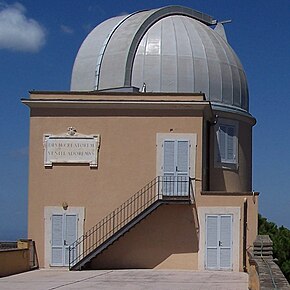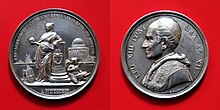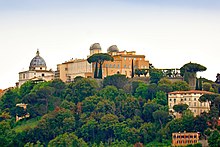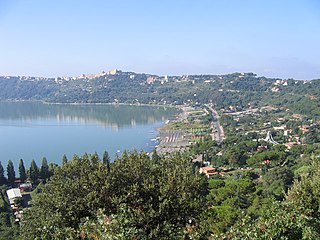
Castel Gandolfo, colloquially known as Castello in the Castelli Romani dialects, is a town located 25 km (16 mi) southeast of Rome, in the Italian region of Lazio. Situated on a hilltop in the Alban Hills with panoramic views of Lake Albano, Castel Gandolfo is home to approximately 8,900 residents and is renowned as one of Italy's most scenic towns. It is one of I Borghi più belli d'Italia.
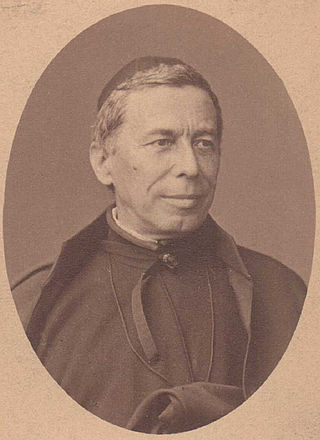
Angelo Secchi was an Italian Catholic priest, astronomer from the Italian region of Emilia. He was director of the observatory at the Pontifical Gregorian University for 28 years. He was a pioneer in astronomical spectroscopy, and was one of the first scientists to state authoritatively that the Sun is a star.

The properties of the Holy See are regulated by the 1929 Lateran Treaty signed with the Kingdom of Italy. Although part of Italian territory, some of them enjoy extraterritoriality similar to those of foreign embassies.
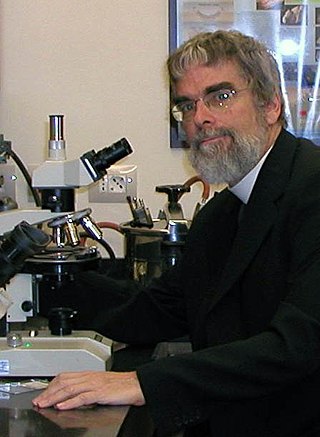
Brother Guy J. Consolmagno, SJ, is an American research astronomer, physicist, religious brother, director of the Vatican Observatory, and President of the Vatican Observatory Foundation.
Vatican Radio is the official broadcasting service of Vatican City.

George Vincent Coyne, S.J. was an American Jesuit priest and astronomer who directed the Vatican Observatory and headed its research group at the University of Arizona from 1978 to 2020.

The Pontifical Commission for Vatican City State is the legislative body of Vatican City. It consists of a president, who also holds the title of President of the Governorate of Vatican City State and serves as the head of government of Vatican City, as well as seven other cardinals appointed by the pope for five-year terms.

Johann (John) Georg Hagen was an Austrian Jesuit priest and astronomer. After serving as Director of the Georgetown University Observatory he was called to Rome by Pope Pius X in 1906 to be the first Jesuit director of the new Vatican Observatory. Father Hagen was also the spiritual director of Maria Elizabeth Hesselblad (1870-1957), who was baptized by him on August 15, 1902 and eventually was canonized on June 5, 2016 by Pope Francis.
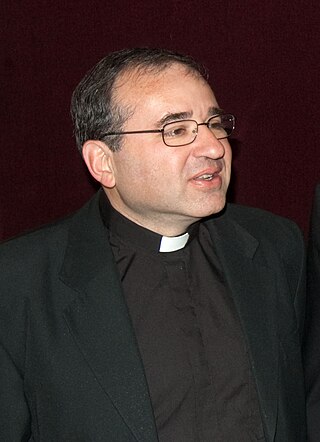
José Gabriel Funes, S.J. is an Argentine Jesuit priest and astronomer. He was the Director of the Vatican Observatory from August 19, 2006, until September 18, 2015, when he was succeeded by Pope Francis's appointment of Brother Guy Consolmagno, S.J. Funes serves on the Advisory Council of METI.

The Roman College was a school established by St. Ignatius of Loyola in 1551, just 11 years after he founded the Society of Jesus (Jesuits). It quickly grew to include classes from elementary school through university level and moved to several successive locations to accommodate its burgeoning student population. With the patronage of Pope Gregory XIII, the final seat of the Roman College was built in 1584 near the center of Rome's most historic Pigna district, on what today is called Piazza del Collegio Romano, adding the church of St. Ignatius in 1626, and a renowned observatory in 1787. The college remained at this location for 286 years until the revolutionary Capture of Rome in 1870.

The Vatican Railway was opened in 1934 to serve Vatican City and its only station, Vatican City. The main rail tracks are standard gauge and 300 metres (980 ft) long, with two freight sidings, making it the shortest national railway system in the world. Access to the Italian rail network is over a viaduct to Roma San Pietro railway station, and is guaranteed by the Lateran Treaty dating from 1929. The tracks and station were constructed during the reign of Pope Pius XI, shortly after the treaty.

Francesco Denza was an Italian meteorologist and astronomer.

William R. Stoeger SJ was an American astronomer and theologian.

The relationship between science and the Catholic Church is a widely debated subject. Historically, the Catholic Church has been a patron of sciences. It has been prolific in the foundation and funding of schools, universities, and hospitals, and many clergy have been active in the sciences. Some historians of science such as Pierre Duhem credit medieval Catholic mathematicians and philosophers such as John Buridan, Nicole Oresme, and Roger Bacon as the founders of modern science. Duhem found "the mechanics and physics, of which modern times are justifiably proud, to proceed by an uninterrupted series of scarcely perceptible improvements from doctrines professed in the heart of the medieval schools." Historian John Heilbron says that “The Roman Catholic Church gave more financial and social support to the study of astronomy for over six centuries, from the recovery of ancient learning during the late Middle Ages into the Enlightenment, than any other, and probably all, other Institutions.” The conflict thesis and other critiques emphasize the historical or contemporary conflict between the Catholic Church and science, citing, in particular, the trial of Galileo as evidence. For its part, the Catholic Church teaches that science and the Christian faith are complementary, as can be seen from the Catechism of the Catholic Church which states in regards to faith and science:
Though faith is above reason, there can never be any real discrepancy between faith and reason. Since the same God who reveals mysteries and infuses faith has bestowed the light of reason on the human mind, God cannot deny himself, nor can truth ever contradict truth. ... Consequently, methodical research in all branches of knowledge, provided it is carried out in a truly scientific manner and does not override moral laws, can never conflict with the faith, because the things of the world and the things of faith derive from the same God. The humble and persevering investigator of the secrets of nature is being led, as it were, by the hand of God despite himself, for it is God, the conserver of all things, who made them what they are.

The Papal Palace of Castel Gandolfo, or the Apostolic Palace of Castel Gandolfo from its Italian name Palazzo Apostolico di Castel Gandolfo, is a 135-acre (54.6-ha) complex of buildings in a garden setting in the city of Castel Gandolfo, Italy, including the principal 17th-century villa, an observatory and a farmhouse with 75 acres (30.4 ha) of farmland. The main structure, the Papal Palace, has been a museum since October 2016. It served for centuries as a summer residence and vacation retreat for the pope, the leader of the Catholic Church, and is afforded extraterritorial status as one of the properties of the Holy See. It overlooks Lake Albano.

The Gregorian Tower or Tower of the Winds is a square tower and early modern observatory located above the Gallery of Maps, which connects the Villa Belvedere with the Apostolic Palace in Vatican City. The tower was built between 1578 and 1580 to a design by the Bolognese architect Ottaviano Mascherino mainly to promote the study of astronomy for the Gregorian Calendar Reform which was commissioned by Pope Gregory XIII and promulgated in 1582. It was then also known as the Tower of Winds. The tower was also called "Specola Astronomica Vaticana", a reference to the Vatican Observatory. Four stages of progressive development have occurred since it was first established. The tower was an edifice of great value for astronomical observations made using a sundial as they provided essential confirmation of the need to reform the Julian calendar.
The term Specola in Italian means observatory, a location used for observing terrestrial or celestial events. A number of palaces, institutes, museums and observatories in Italy carry the name, because at one time or another they housed an observatory. Among these:

Giuseppe Calandrelli was an Italian priest, astronomer and mathematician. He founded the first astronomical observatory in the Collegio Romano in 1787. An uncle of the astronomer Ignazio Calandrelli, he was among the first to observe the parallax of stars, estimate the masses of comets, the potential size of their atmosphere, and to examine the use of barometers to mathematically estimate altitudes.
Ileana Chinnici is an Italian historian of astronomy, book author, and biographer, whose biography of Angelo Secchi won the 2021 Osterbrock Book Prize of the American Astronomical Society.
